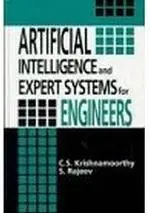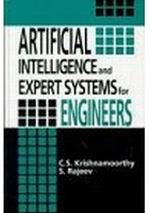Artificial Intelligence and Expert Systems for Engineers, Author: C.S.
Krishnamoorthy; S. Rajeev | Publishing : CRC; Bk&Disk edition | ISBN :
0849391253 | PDF | 1.39 MB | 254 pages | 1996
Krishnamoorthy; S. Rajeev | Publishing : CRC; Bk&Disk edition | ISBN :
0849391253 | PDF | 1.39 MB | 254 pages | 1996
Preface
The book is aimed at bringing out a comprehensive presentation of Artificial
Intelligence (AI) based methodologies and software tools wherein, for the
first time, the focus is on addressing a wide spectrum of problems in
engineering.
Expert system methodology has been applied in the past to a number of problems
of planning, design, diagnostics etc. However, the problems of engineering
design have not been adequately addressed, since these problems have to be
addressed in an integrated manner with knowledge from different domains and
sources.
Continued research in the last ten years has recently resulted in the
emergence of new methodologies which will enable building of automated
integrated design systems that will have the ability to handle the entire
design process. These methodologies include design synthesis, design
critiquing, case-based reasoning etc., leading to concurrent engineering.
Details of these methodologies and tools are at present available only in the
form of technical papers and reports of research projects that have been
carried out in academic and other institutions.
Many research and development projects have been carried out by the authors in
the past few years, and prototype systems have been developed for specific
applications to engineering systems. During this process, the authors have
proposed generic frameworks and have developed efficient software tools to
meet the requirements of engineering design. This intensive work, coupled with
the teaching of a graduate course on Computer-Aided Design, motivated the
authors to write a book on the subject with descriptions of different
methods and a presentation of software tools that meet the requirements of
integrated knowledge-based systems in engineering. The authors hope that the
book will serve as a textbook for students and teachers, and
the software frameworks and tools will provide the requisite resource material
to researchers and professionals who are interested in developing knowledge-
based systems in various disciplines of engineering.
The book is divided into seven chapters. The first chapter presents an
overview of the developments in the areas of AI and Knowledge-Based Expert
System (KBES) applications to engineering. The relevance and importance of the
use of AI-based methodologies for solving engineering problems are well
brought out in this chapter.
The predominant component of any AI-based program is in the extensive use of
search techniques. Depending on the nature of the problem being solved and the
context, appropriate search techniques are to be adopted.
Chapter 2 presents different search techniques used in AI-based programs.
KBES is the most popular and successful of the AI-based tools, that have been
evolved to address problems in planning, diagnosis, classification, monitoring
and design. Different knowledge representation schemes such as rules, semantic
nets and frames are presented in Chapter 3. Inference mechanisms which drive
the knowledge base are also presented with the help of simple engineering
examples. The architecture of an expert system shell, developed by the
authors, called DEKBASE (Development Environment for Knowledge-Based Systems
in Engineering) is presented along with the examples illustrating the use of
DEKBASE to develop production rule-based expert systems.
Chapter 4 presents the concepts of design synthesis and the techniques used to
generate multiple solutions with predefined constraints. The domain
decomposition-recomposition technique useful for engineering design is
explained with examples. The architecture and framework for design synthesis
and computer implementation of a generic tool, GENSYNT (GENeric SYNthesizing
Tool), are presented and the use of GENSYNT is explained through examples.
Engineering design process involves use of knowledge sources from different
domains. Any feasible solution generated from the consideration of one domain
has to be evaluated for satisfaction of the concerns of other domains
participating in the process. A methodology for design critiquing and
evaluation of a solution is presented in Chapter 3. The architecture of
GENCRIT (GENeric CRItiquing Tool) is explained with sample
problems.
Another major development in AI-based methodology is the emergence of Case-
Based Reasoning (CBR) which aims at generation of solutions based on past
cases stored in casebases with the application of appropriate reasoning
mechanisms. The requirements of a CBR-based model for engineering design and a
generic frame work, CASETOOL (CASE-based reasoning TOOL), are presented in
Chapter 6. Engineering design involves a class of complex generative tasks
whose solutions depend on the cooperative participation of multiple
specialists. In order to develop a knowledge-based system an analysis of all
the tasks involved has to be performed. Based on the task analysis the
developer has to identify the AI methodologies needed and propose a process
model for the system. The process model should facilitate horizontal and
vertical integration of the tasks involved in the entire design process. For a
better understanding of the process models needed for developing knowledge-
based systems for real-life problems, case studies of typical prototype
systems are presented in chapter 7. It is felt by the authors that an
understanding of AI-based methodologies, and the generic framework and tools
presented in the book, can be made more effective, if readers get an
opportunity to use these tools on computers and acquire hands-on experience.
Educational versions of the four software tools are provided in the floppy
diskette. The software DEKBASE with a rule base inference engine and a frame
management system provides a platform for inclusion of other generic tools,
GENSYNT, GENCRIT and CASETOOL. The tools are implemented on PC-based systems
under a DOS environment. The use of the software tools is illustrated in the
Appendices I to III for the examples described in various chapters of the
book. The authors would like to acknowledge that it was the Indo-US project
under the NSF grant INT 8913816 on KBES for Civil Engineering Design, in
collaboration with Professor Steven J. Fenves of Carnegie-Mellon
University, that had significantly contributed to the development of the
software tools, particularly DEKBASE, presented in this book. The authors
would like to express their gratitude to Professor Steven J. Fenves for his
interaction through the above project which provided the motivation to the
authors for the research and development work in this area.
The four software modules presented in this book are due to the dedicated
efforts of the Indo-US project team and the authors would like to place on
record their deep appreciation and gratitude to the project officers,
affectionately referred to as Indo-Americans, M/s. C.S. Rao, S. Suresh and H.
Shiva Kumar. The authors thank Mr. Shaikh Karimulla Raja for his contribution
to the development of a few modules of DEKBASE and to a number of graduate
students for testing DEKBASE. The authors would also like to acknowledge Mr.
H. Shiva Kumar and Mr. S. Suresh for their contributions in the development of
two prototype systems SETHU and ODESSY which are presented as case studies in
this book and for their inputs at various stages of writing this book. The
case study dealing with the design of the shape of the body of a car was based
on the project work carried out by M/s. Harshawardhan Shetty and Biju Baby
under the direction of Dr. N. Ramesh Babu of the Mechanical Engineering
Department at IIT, Madras, and the authors would like to thank them for
contributing to the development of the system described in Chapter 7.
The authors would like to thank their faculty colleagues Professor V.
Kalyanaraman and Professor N. Rajagopalan for their technical contribution as
co-investigators of the Indo-US project. The description in
Chapter 7 of GENESIS, a prototype system for plannnig and design of steel
industrial structures, and of the architecture of the Integrated Engineering
System (IES), is based on the work of Dr. S. Sakthivel under the direction of
our colleague Professor V. Kalyanaraman. The authors would like to thank them
for making it possible to include them in this book.
The authors sincerely thank Mr. R. S. Jeevan, Project Associate, for his
excellent support in typesetting and preparation of camera-ready format for
the book and Mr. S. Suresh for assistance at various stages in the
preparation of the manuscript. Thanks are due to Manoj Thomas and to Muthusamy
and Sankari of the Departmental Computer Facility and Ambika Devi for their
help. The authors would like to thank the authorities of the Indian Institute
of Technology, Madras and particularly acknowledge the CE Departmental
Computer Facility where the software development work was carried out.
The fillip to write this book came from Professor W.F. Chen of Purdue
University. It was his suggestion that the authors write a book under a series
that he has been editing. The authors would like to thank Professor
Chen for his encouragement and to Mr. Navin Sullivan and Ms. Felicia Shapiro
of CRC Press for their support in the publication of this book.
Chapter 1—Introduction
Chapter 2—Search Techniques
Chapter 3—Knowledge-Based Expert System
Chapter 4—Engineering Design Synthesis
Chapter 5—Criticism and Evaluation
Chapter 6—Case-Based Reasoning
Chapter 7—Process Models and Knowledge-Based Systems



